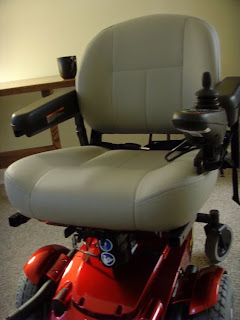[MY FEBRUARY 2010 COLUMN FROM VOICES OF CENTRAL PENNSYLVANIA]
From Where I Sit
“…Dr. [Margaret] Pfanstiehl…said her goal was to engage the sight-deprived to‘live a 20/20 existence without 20/20 vision.’”
Dr. Pfanstiehl, mourned last month in a Maryland ceremony, was blind and promoted audio description technology to the point where a blind patron can hear audio description of dance.
From where I sit on my $5,000 power chair, two issues come to mind immediately. First, President Obama, the man I supported to be president, plans to reduce the Medicare budget by nearly half a trillion dollars. These cuts, intended to help pay for health care reform, have come on top of procedures that hurt me and others who are elderly or disabled. The argument is that current and future cuts will reduce “fraud
and abuse.” Attorney General Eric H. Holder, Jr.’s fraud and abuse prosecutions are notable for their relative insignificance.
The second issue that comes to mind is when elderly and disabled voters are organized,
they constitute an effective voting bloc. As I write this column in Addison Court in State College, I note that Addison Court has about 90 residents who are 55 or older or who have disabilities or impairments.
Most of us are registered and vote even in low-turnout elections. Addison Court now has a tradition of iinviting candidates to inform our residents about the issues. To date, residents (eating
Elaine Mede-Wilgusr donated food from Webster’s Café) have heard R e p r e s e n t a t i v e
Glenn (GW) Thompson, his challenger Mark C. McCracken (currently a Clearfield County commissioner),
Assemblyman Scott Conklin, State College Mayor Elizabeth Goreham, and four State
College Borough Council candidates representing both major parties.
When George Bush was president, he attacked Medicare, creating barriers that
made it more difficult for eligible citizens to obtain medical oxygen for homecare,
wheelchairs, power chairs and scooters.
To take me as an example, in March 2008 a power chair was prescribed for me after (in-patient
hospitalization at Health South). I received a thorough evaluation from physical and
occupational therapy. My physician, Dr Colin McCaul, a specialist in rehabilitation,
prescribed the chair because he said it would be useful for me to have more support
for my right arm, helping to avoid surgery.
It would also be useful teaching my left arm how to perform functions previously
done by my right. The chair’s controls are on my left causing much trouble
before I finally learned how to drive lefthanded.
Medicare required that I go through an hour-and-a-half test with a rehabilitation
specialist. After passing the test, I saw Dr. McCaul in the hallway. The rehabilitation specialist
emphasized the importance of the doctor scheduling a one-on-one appointment devoted strictly to why I need a power chair and to be followed by a paper prescription with the magic words on top “after a one-on-one appointment.”
Since I had seen Dr. McCaul immediately before the test, he said it wasn’t necessary
to meet again. He would take care of it. Medicare, which has been consistently negligent in explaining the rules to physicians rejected the prescription and would not pay. The prescription was not written in keeping with Medicare regulations. [How I obtained payment from an agency other than Medicare
is a story for another time.]
When Obama became president I thought he would reverse those policies. He has
made things worse. Especially distressing is that while Obama has been busy with health
care reform in which Medicare was a significant factor, he had not named a director of
Medicare, the largest health insurance company in the United States. Assistive technology
(which gets me from bed to the bathroom reliably) generally helps the disabled
avoid assistive living (which costs Medicare more than $40,000 extra per person
per year than independent living. Also, independent living
allows a greater sense of independence and helping to improve morale.
I said in my last column that I would discuss John Wayne’s comment that after
cancer surgery he did not feel sorry forhimself, despite the temptation. Wayne
proved it by getting back to work, filming a movie only two weeks after surgery.
For those of us who are disabled, not feeling sorry means having the equipment to
get a job, equipment suc as that listed above.
Assistive technology for the blind especially have resulted in
very exciting developments Disgracefully, technology that is very
useful to help individuals who are blind gain indepence
is not paid by Medicare. We also need technology for those who cannot
hear—only some of which is paid for, including controversial cochlear implants.
The most effective message to the Democratic Party is the creation of a bloc
within the party that will vote strictly on disability and aged concerns—a bloc which
will flirt with the Republicans if it does any good. [It should go without saying that this
bloc would include disabled veterans, but all too often veterans are neglected even
when intentions are best.]
—Joel Solkoff, author of “The Politics of
Food.” Contact him at jsolkoff@gmail.com










